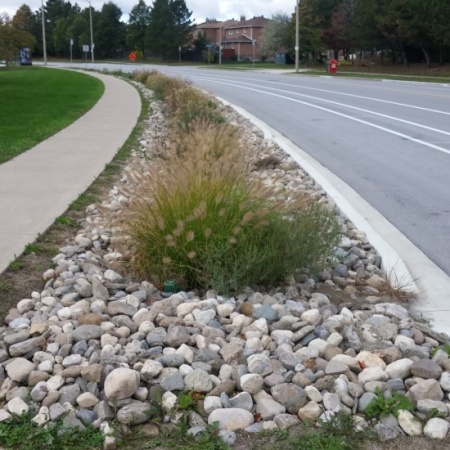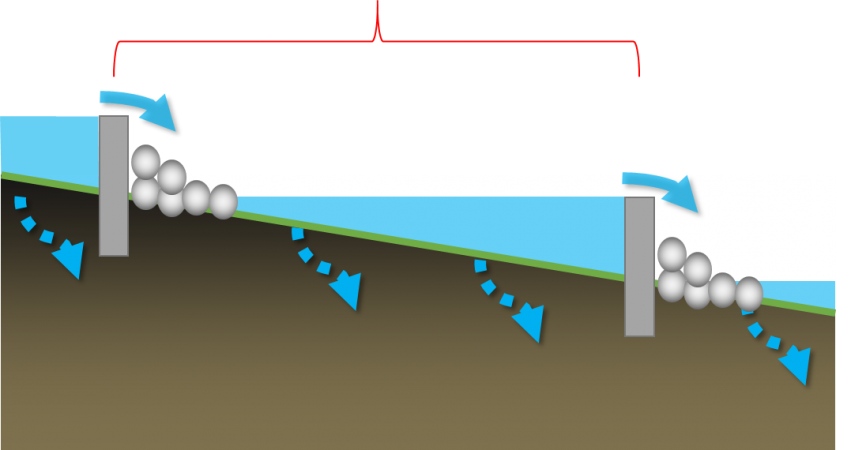Difference between revisions of "Swales"
Jenny Hill (talk | contribs) |
Jenny Hill (talk | contribs) |
||
| Line 12: | Line 12: | ||
*Connecting with one or more other types of LID}} | *Connecting with one or more other types of LID}} | ||
| − | {| style="border-spacing: 2px; border: | + | {| style="border-spacing: 2px; border: 2px solid teal;" |
|+ Types of Swale | |+ Types of Swale | ||
|- | |- | ||
| Line 21: | Line 21: | ||
!Surface water | !Surface water | ||
|Minimal<br>Any surface flow can be slowed with check dams||Ponding is encouraged with check dams | |Minimal<br>Any surface flow can be slowed with check dams||Ponding is encouraged with check dams | ||
| − | + | } | |
<table class="table-responsive" table class="table table-striped"> | <table class="table-responsive" table class="table table-striped"> | ||
Revision as of 19:51, 9 August 2017
This article is about installations designed to capture and convey surface runoff along a vegetated channel, whilst also promoting infiltration.
For underground conveyance which promotes infiltration, see Exfiltration trenches.
Overview[edit]
Swales are linear landscape features consisting of a drainage channel with gently sloping sides. Underground they may be filled with engineered soil and/or contain a water storage layer of coarse gravel material. Two variations on a basic swale are recommended as low impact development strategies, although using a combination design of both may increase the benefits:
- Bioswales are sometimes referred to as 'dry swales', 'vegetated swales', or 'water quality swales'. This type of structure is similar to a bioretention cell but with a long linear shape (surface area typically >2:1 length:width )
- Enhanced grass swales are a lower maintenance alternative, but generally have lower stormwater management potential. The enhancement over a basic grass swale is in the addition of check dams to slow surface water flow and create small temporary pools of water which can infiltrate the underlying soil.
Swales are an ideal technology for:
- Sites with long linear landscaped areas, such as parking lots
- Connecting with one or more other types of LID
| Property | Bioswale | Enhanced grass swale | ||||||||||||||||||||||||||||||||||||
|---|---|---|---|---|---|---|---|---|---|---|---|---|---|---|---|---|---|---|---|---|---|---|---|---|---|---|---|---|---|---|---|---|---|---|---|---|---|---|
| Surface water | Minimal Any surface flow can be slowed with check dams |
Ponding is encouraged with check dams
}
Planning Considerations[edit]A linear design (surface area typically >2:1 length:width) is a common feature of a swales:
Swales may be graded along longitudinal slopes between 0.5 - 6 %:
<panelWarning> </panelWarning> Design[edit]Pretreatment and inletsTo minimize erosion and maximize the functionality of the swale, sheet flow of surface water should be directed into the side of the BMP. Gravel diaphragms, vegetated filter strips and shallow side slopes are ideal. Alternatively, a series of curb inlets can be employed, where each has some form of flow spreading incorporated. Single point inflow can cause increased erosion and sedimentation which will damage vegetation and contribute to BMP failure. Again, flow spreading devices can mitigate these processes, where concentrated point inflow is required. Check damsCheck dams are a feature of enhanced swales. They promote infiltration and evaporation by promoting limited ponding. To design check dams into a swale:
Other components<panelSuccess> </panelSuccess> Performance[edit]<h4blue>Bioswales</h4blue> While few field studies of the pollutant removal capacity of bioswales are available from cold climate regions like Ontario, it can be assumed that they would perform similar to bioretention cells. Bioretention provides effective removal for many pollutants as a result of sedimentation, filtering, plant uptake, soil adsorption, and microbial processes. It is important to note that there is a relationship between the water balance and water quality functions. If a bioswale infiltrates and evaporates 100% of the flow from a site, then there is essentially no pollution leaving the site in surface runoff. Furthermore, treatment of infiltrated runoff will continue to occur as it moves through the native soils.
<h4blue>Enhanced grass swales</h4blue> Construction[edit]
The following presents a summary of considerations when planning the construction of a low impact development project. More details can be found in the following reference:[3]
Sequencing[edit]The following is a typical construction sequence to properly install an infiltration practice:
Facilities containing media[edit]Bioretention[edit]Sequencing depends on the design:
Stormwater planters[edit]
Rain gardens[edit]No storage or drainage is required, filter media or amended topsoil is laid onto native soils Media installation[edit]Media installed over the choker course in 0.3 m lifts until desired top elevation is achieved. Each lift must be thoroughly wetted and drained before adding the next. Wait three weeks to check for settling, and add additional media and regrade as needed.
Checklists[edit]
Incentives and Credits[edit]In OntarioCity of Mississauga LEED BD + C v. 4SITES v.2See Also[edit]External Links[edit] |
||||||||||||||||||||||||||||||||||||
- ↑ Horner RR, Lim H, Burges SJ. HYDROLOGIC MONITORING OF THE SEATTLE ULTRA-URBAN STORMWATER MANAGEMENT PROJECTS: SUMMARY OF THE 2000-2003 WATER YEARS. Seattle; 2004. http://citeseerx.ist.psu.edu/viewdoc/download?doi=10.1.1.365.8665&rep=rep1&type=pdf. Accessed August 11, 2017.
- ↑ https://www.pca.state.mn.us/sites/default/files/p-gen3-14g.pdf
- ↑ [https://cvc.ca/wp-content/uploads/2013/03/CVC-LID-Construction-Guide-Book.pdf Construction Guide for Low Impact Development, CVC (2013)



